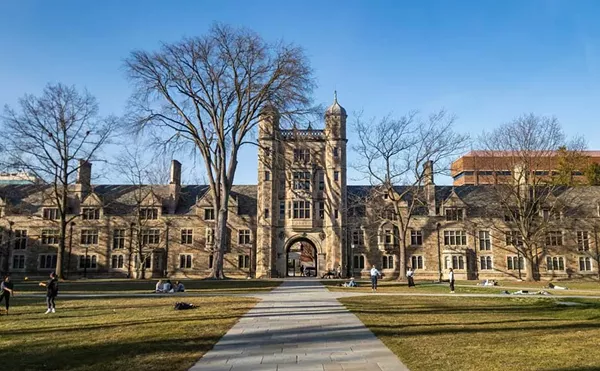It may not be rolling with the force of a freight steaming downhill, but Washtenaw County officials say efforts to establish commuter rail service between Ann Arbor and Detroit are gaining substantial momentum.
Key to the whole project is a study under way to determine whether potential ridership will be enough to convince the federal government that the plan is worthwhile.
U.S. Sen. Debbie Stabenow got the process started while still in the U.S. House, pushing to fund a study analyzing the viability of commuter rail service between Detroit and Lansing. Although the study found high interest among potential riders, it was determined that, because of high construction and operating costs, obtaining crucial funding from the Federal Transit Administration would be too tough a sell. The estimated costs for constructing and equipping the 98-mile line would top $130 million; operating costs would be about $6.2 million annually.
However, because the potential for ridership on a line running between Ann Arbor and Detroit appeared to be exceptionally strong, planners narrowed the scope of the project, with the Ann Arbor Transit Authority assuming the lead.
No current estimates are yet available for the costs of the shorter route. Officials at the Ann Arbor Transit Authority say their study is still in progress, and that solid estimates may be available in February. But experts say the savings would be significant. For one thing, the entire rail line between Ann Arbor and Detroit already exists. The Lansing route would have required construction of a bridge over the Huron River, representing tens of millions of dollars in start-up expenses that have been jettisoned.
A 1997 study commissioned by the Michigan Department of Transportation predicted the start-up costs for a Detroit/Ann Arbor route would be close to $50 million, including the purchase of locomotives and passenger cars. It was also estimated that operating costs would be about $8.2 million per year.
Where’s the money?
The big question that remains is how much of the operating costs riders will provide, and how much various levels of government will be willing to cough up to subsidize operations.
With all levels of government facing daunting budget deficits, and with the public showing an increasing unwillingness to support new taxes, finding a source of subsidies won’t be easy, predicts Washtenaw County Administrator Robert Guenzel.
Even so, he and Ann Arbor Mayor John Hieftje say they are firmly behind the plan, as are the county commission and City Council.
Less clear is the level of support on the eastern end. Mayor Kwame Kilpatrick’s office did not return calls seeking comment; neither did Claryce Gibbons-Allen, director of the Detroit Department of Transportation.
Wayne County Executive-elect Robert Ficano says he’s interested in exploring the issue, but that a number of questions must be answered before he would throw his full support behind the proposal.
Wayne County and Detroit would both benefit from a commuter rail line running west, says Tim Johnson, spokesperson for the county’s Jobs and Economic Development Department. That’s especially true now that the Pinnacle Aeropark, a multifaceted development slated for 1,400 acres adjacent to Wayne County Metropolitan Airport, is moving ahead. Commuter rail service, says Johnson, “would help more Detroiters share in the economic benefits” generated by the airport and development around it.
Even so, it appears that the folks in Washtenaw County are the prime force in moving the plan forward.
“The real momentum for this is coming from the west,” says Kelly Thayer, a transportation specialist for the Michigan Land Use Institute, a nonprofit environmental group. “What I’m hearing is that there’s good transit agency energy behind this, and good citizen energy. It looks like the Ann Arbor Transit Authority’s plan is to use the commuter rail line as the backbone of its system, allowing it to extend the reach of bus service throughout Washtenaw County so that it is more extensive.”
“In my opinion,” adds Thayer, “I think it (the rail line) is going to happen. This is a lot more than just some study that’s going to sit on a shelf.”
Help on the way
Likewise, Kirk Profit, a former Michigan legislator now working as a lobbyist, says the forces necessary to make the plan a reality are coming into alignment. Michigan’s congressional delegation is on board, and there’s bipartisan support in the Michigan House, says Profit, whose company, Government Consultant Services, lists as clients Ann Arbor, Washtenaw County and Detroit. Further buoying hope is the promise that Gov.-elect Jennifer Granholm will be much more supportive of mass transit than the John Engler administration.
Even with that support, however, establishing the rail service won’t be an easy task.
“On the surface, it sounds like a pretty easy project,” says Carmine Palombo, director of transportation programs for the Southeast Michigan Council of Governments (SEMCOG). “But there are a lot of complications that have to be dealt with.”
For starters, he explains, there’s the fact that Amtrak and freight haulers already run along the same rails commuter trains would utilize, so usage agreements would need to be negotiated.
There’s also the task of shaking money loose from the Federal Transit Administration, which sets strict conditions that must be met before it will help finance any project.
Initial studies done by SEMCOG have shown the project could be feasible, but more definitive projections are needed.
“Conceptually, there is a lot of support,” says Palombo, “but at the end it all comes down to how much this will cost compared to what the benefits will be. I hope the study that’s under way right now shows that there are a lot of people willing to use the service, because the more people there are who are willing to use it, the more cost-effective it will be.”
If everything falls into place, it’s possible the line could be up and running by 2006, says Guenzel. He cautions that if proponents of the plan don’t push it through now, another opportunity may be far down the line.
“Right now, a lot of individuals of good will have a positive vision,” says Guenzel. “With that going for us, we have a real chance.”
Curt Guyette is the Metro Times news editor. Call 313-202-8004 or e-mail [email protected]





